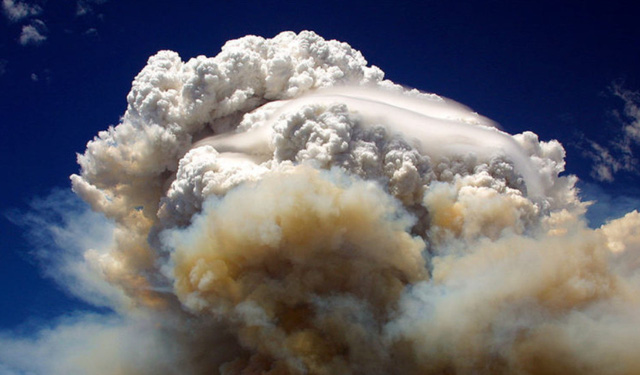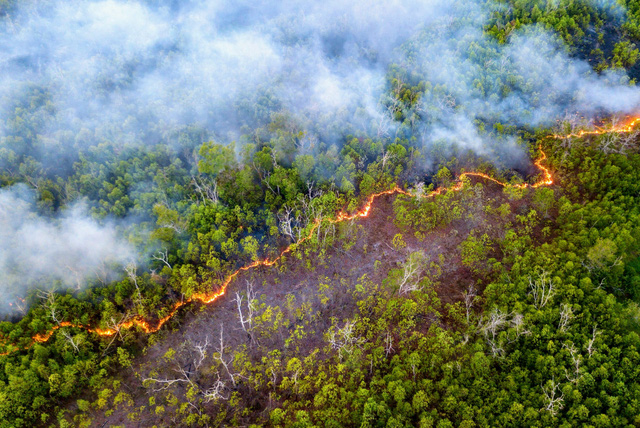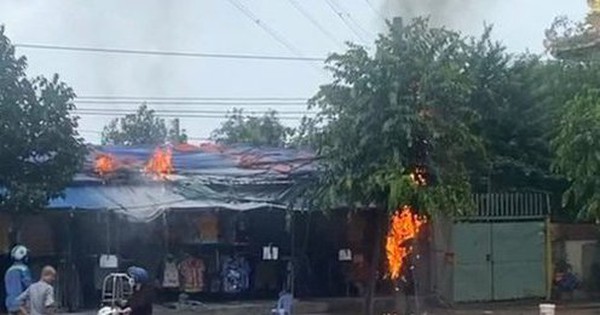Battle Forest fires in Australia in 2019 and 2020 terrified the world as wildfires spread, raged and destroyed herbs and homes, killing billions of animals. More than 17 million hectares of land have been burned and more than 1 million tons of seeds have been burned smoke (particles of suspended matter produced after incomplete combustion) are released into the atmosphere.

This giant smoke cloud pyrocumulonimbus has entered the atmosphere up to 35 km, deep into the stratosphere, where the ozone layer is located. The mass and extent of dust particles reaching the stratosphere are proportional to the effects of volcanic eruptions.
In previous research, Susan Solomon, Lee Professor of Environmental Studies, and Geraldine Martin at the Massachusetts Institute of Technology have found that particles released during volcanic eruptions can damage the ozone layer through the atmosphere through a series of chemical reactions.
These tiny particles of matter collect water vapor on their surface, and once wet, they provide surface area for many reactions between the stratospheric particles, including those that lead to the destruction of the ozone layer. After the fires in Australia died down in March 2020, he wondered if smoke particles from the fires would have the same effect and accelerate ozone depletion?
Smoke from forest fires is a “catalyst” that destroys the ozone layer
In a new study, Solomon and a team of atmospheric scientists from MIT confirm that smoke from catastrophic fires causes chemical reactions in the stratosphere that contribute to ozone depletion. The study is the first to establish a chemical link between wildfire smoke and ozone layer depletion.
After the fires subsided in March 2020, scientists noted a sharp drop in NO2 in the stratosphere. This is the first step in a series of reactions that lead to ozone depletion. The researchers found that the reduction in NO2 was directly correlated with the amount of smoke entering the stratosphere from fires.
Thus, during volcanic eruptions, the tiny particles create a surface for a chemical reaction to form nitric acid (HNO3) from dinitrogen pentoxide (N2O5), a chemical circulating in the stratosphere. N2O5 normally reacts in sunlight and produces a variety of nitrogen compounds, including NO2, which reduces the effects of chlorine-containing gases and is responsible for ozone depletion.
So when volcanic smoke converts normal N2O5 into HNO3, the concentration of NO2 decreases and this causes excess chlorine-containing gas. These chlorine-containing gases can be referred to as CFCs and HCFCs. These are all major man-made agents and threaten to destroy the ozone layer.
As soon as atmospheric scientists noted NO2 depletion in the stratosphere following a fire, they predicted this would cause ozone layer damage, as observed after volcanic eruption events. In fact, in the study, scientists estimated that a chemical chain reaction caused by smoke particles in the stratosphere would deplete ozone by 1%.
Professor Solomon, lead author of the study said: “Once the NO2 is reduced, there will be more chlorine monoxide (ClO), and that will deplete the ozone.”.
The team used measurements of stratospheric NO2 taken by three independent satellites that surveyed the Southern Hemisphere at different time intervals. They compared each satellite’s record to the time after the Australian fires. All three showed a significant drop in NO2 levels in March 2020. For a single satellite record, the lunar data was the lowest on record among observations in the last 20 years.

The researchers then used a three-dimensional global model to simulate the potential effects of wildfire smoke on the atmosphere. This model maps hundreds of chemical reactions that occur in the atmosphere, from the Earth’s surface to the stratosphere.
As part of the modeling test, they introduced a “smoke particle cloud” to the model to mimic observations from fire. They assumed particles such as volcanic aerosols would collect water vapor, and then they ran the model several times to compare the results, with and without smoke clouds.
In each simulation that included bushfire smoke, the team found that as the volume of smoke particles increased in the stratosphere, NO2 concentrations decreased, according to real-time observations made by three satellites.
Solomon shared: “The behavior we’re seeing is less and less aerosols and NO2, both in the model and in the data. This is a very clear sign. This is the first time science has established a chemical mechanism. Science links forest fire smoke to ozone depletion. This could be just one mechanism. chemistry of a lot, but it’s definitely there.”
Unfortunately, the loss of 1% of the ozone layer as a result of the Australian bushfires is comparable to the recovery of the ozone layer that has occurred since the approval of the Montreal Protocol to halt production of ozone-depleting gases.
Because, as a result of the fire almost destroyed all achievements. Not to mention that climate change will lead to more frequent forest fires in the future, and ozone depletion will continue to be a more serious problem.
Solomon said: “The Australian fires appear to be the largest event to date, but as the world continues to warm, there is reason to think these fires will become more frequent and more intense. That is the word. other wake-up calls, such as the Antarctic ozone hole. “
The study was recently published in the journal Proceedings of the National Academy of Sciences.
Refer to Earth
at Blogtuan.info – Source: Soha.vn – Read the original article here



